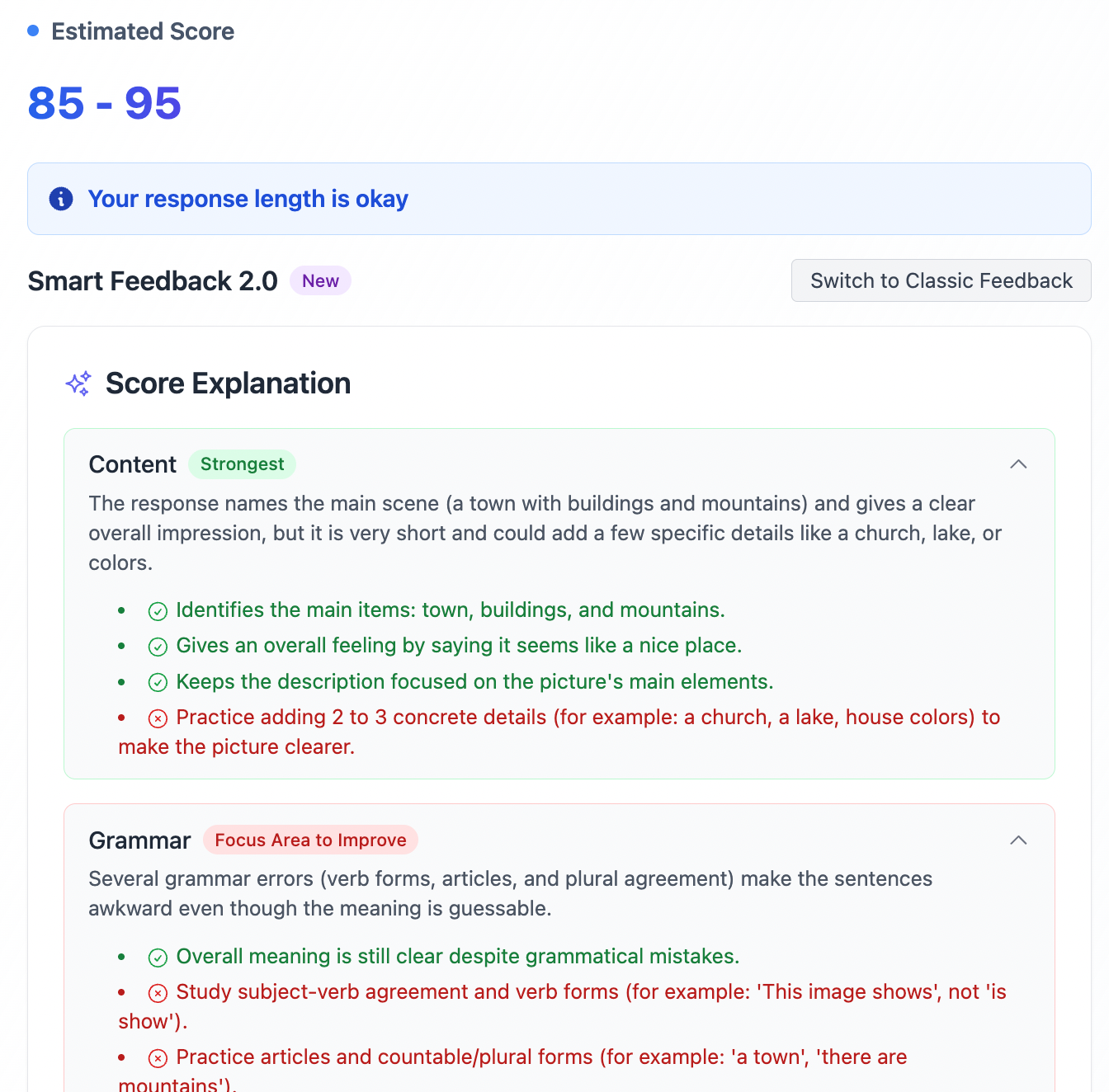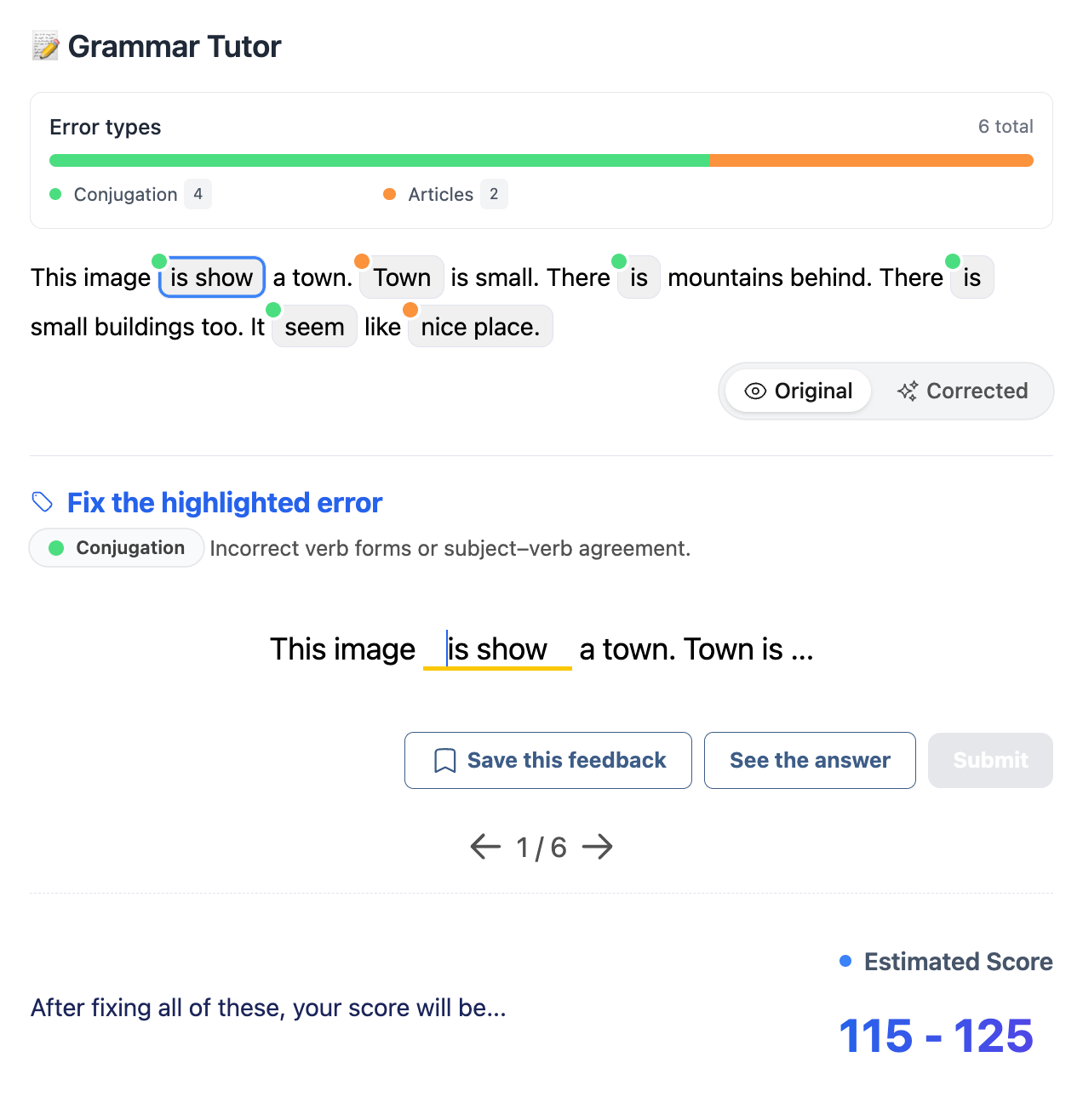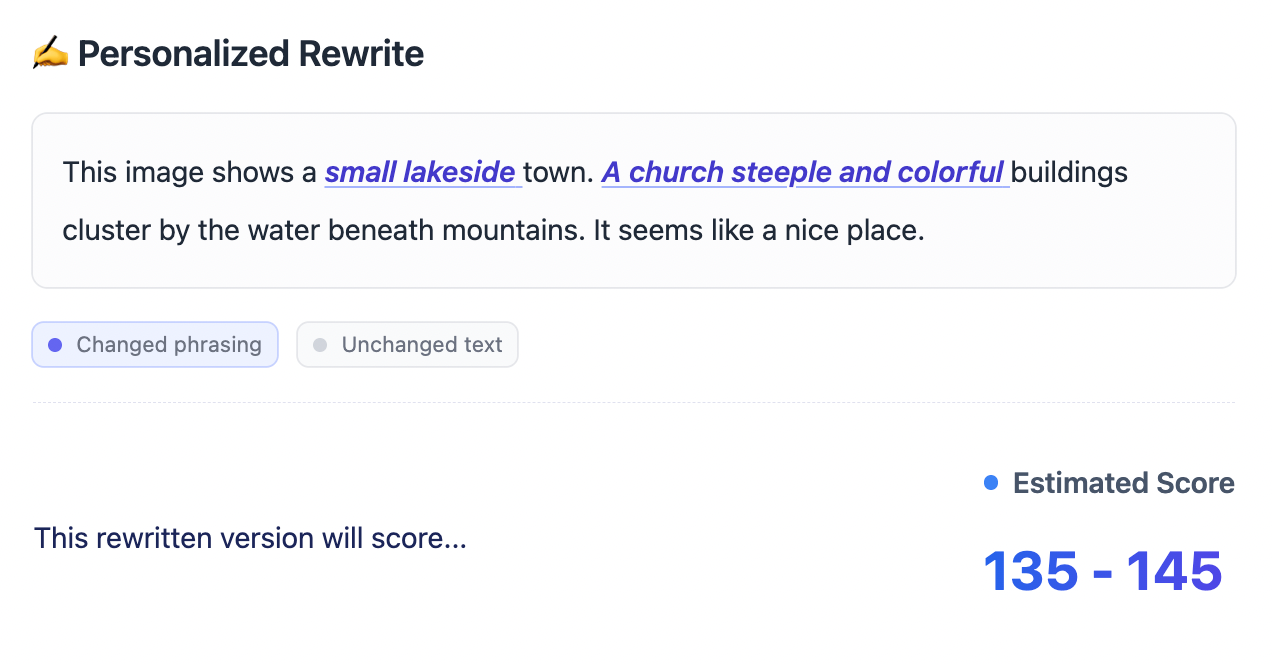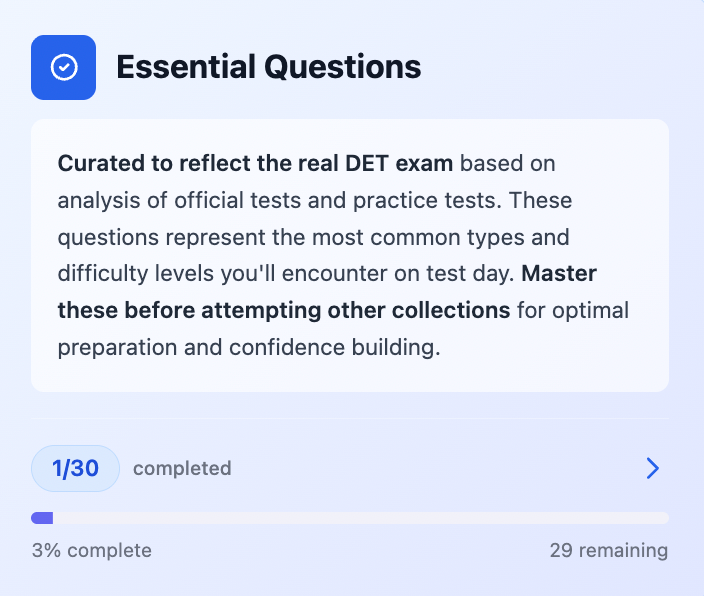Ultimate Guide to Writing Questions - Duolingo English Test
There are 4 kinds of writing questions on the DET, and in this guide, you're going to learn the key information needed to get a high score on all of them.

Table of Contents
- The Writing Question Types on the Duolingo English Test
- How Duolingo Grades Writing Questions
- Tips to Do Well on DET Writing Questions
- Conclusion

The Writing Question Types on the Duolingo English Test
- Write About the Photo: You are given 60 seconds to write a description of an image. You are not given any time to prepare your answer, so you have to write quickly. You will have 3 Write About the Photo questions on the test.
- Summarize the Conversation (Interactive Listening): At the end of an Interactive Listening set of questions, you are given 75 seconds and you have to write a summary of the conversation you just had. There are 2 sets of Interactive Listening questions on the DET, so you will have 2 Summarize the Conversation questions.
- Interactive Writing: This question has 2 parts. In part A, you are given a prompt and 30 seconds to read it and prepare your answer. Then, you write for 5 minutes. Once those 5 minutes are up, you are given a second prompt on the same topic and you have 2.5 minutes to write a response. For part B, you are not given any time to prepare. There is just 1 Interactive Writing question on the test.
- Writing Sample: The Writing Sample is exactly the same as Part A of Interactive Writing. You are given a prompt, 30 seconds to prepare, and then 5 minutes to write. The Writing Sample is graded, and your response itself is sent along with your DET scores. This allows universities to review your writing for themselves.
How Duolingo Grades Writing Questions
There is a lot of overlap in the scoring criteria for writing and speaking questions.
- Content
- Task achievement / Relevance: How well does the test taker answer the question?
- Appropriacy of style: Does the test taker use an appropriate level of formality for the question? Do they use more first-person language when speaking about themselves?
- Development: How well does the test taker present and develop their ideas?
- Effect on the reader or listener: How clearly does the test taker communicate their ideas?
- Discourse coherence
- Clarity: How easy is it to understand the test taker’s ideas and position?
- Cohesion: How well are parts of the answer connected?
- Progression of ideas: Does the order of ideas in the answer make sense?
- Structure (writing questions only): How well is the answer organized at a ‘global’ level? Does the test taker use paragraphs where applicable?
- Grammar
- Grammatical complexity: Does the test taker use a range of grammatical structures to express their ideas?
- Grammatical accuracy: How accurately are grammatical structures used? Do grammatical mistakes make the answer difficult to understand?
- Punctuation: How accurate is the punctuation? Do punctuation errors make the message difficult to understand?
- Lexis (Vocabulary)
- Lexical diversity: Does the test taker use a range of words and phrases to express themselves? Are they able to avoid repetition?
- Lexical sophistication: How well does the test taker use less common words and phrases to express their ideas more precisely?
- Word choice: Do the words that the test taker used make sense? Are they natural and appropriate for the question? Do errors in word choice stop the test taker from being understood?
- Word formation: Are the forms of the words used correct?
- Spelling: How accurately does the test taker spell words? (Note: US or UK spelling conventions are both acceptable.) Do spelling mistakes make the answer difficult to understand?
The scoring criteria are very detailed, so they may be overwhelming. Allow me to simplify them. Here are the 3 things that you should focus on in writing questions:
- Answer the prompt you are given: Your response must answer the prompt that you are given. An off-topic response will lose a ton of points. If your response is too far off topic, Duolingo may not even certify your results.
- Focus on expressing your ideas clearly: In English academic writing, the most important thing is making your ideas easy to understand. Many students try to use advanced vocabulary or complex grammatical structures to gain points, but they use these advanced things incorrectly and their writing becomes difficult to understand, so they lose a lot of points.
- Avoid grammar mistakes: Grammar mistakes make your writing hard to understand. Mistakes related to basic grammar concepts – like spelling, verb conjugation, or articles – lose you the most points.
Tips to Do Well on DET Writing Questions
Next, we'll look at what you can do before and during the test to get high scores on writing questions. You can read more about each tip below.
Before the test
- Learn templates for Write About the Photo and Summarize the Conversation
- Learn the 3 prompt types for Interactive Writing and the Writing Sample
- Learn how to plan your response
- Learn how to write strong paragraphs
- Learn connecting words
- Learn templates for Argue prompts
- Study model answers
- Practice with feedback
- Answer Arno's essential questions
- Improve your typing speed
During the test
- Plan your response
- Write enough
- Proofread
Learn templates for Write About the Photo and Summarize the Conversation
Templates are valuable for every writing and speaking question, but they are especially valuable for Write About the Photo and Summarize the Conversation because these questions are so short. You want to spend as much time as you can writing and as little time as possible thinking about what to say.
First, watch our lessons to learn the templates for each one.
👉 Write About the Photo:
👉 Summarize the Conversation:
Then, practice with these templates inside of Arno. With a free Arno account, you get unlimited practice questions for every question type for free, so it's a great tool to practice specific aspects of the test. Just click here to create your account.
On our paid plans, you can also get an instant score and detailed feedback on your responses that shows you exactly how to gain points. (When you create a free plan, we give you 5 free credits so that you can check out these advanced features and see if they're worth paying for.)



To get started with your free Arno account, just click here.
Learn the 3 prompt types for Interactive Writing and the Writing Sample
For the extended writing and speaking questions, Duolingo has 3 kinds of prompts:
- Recount: Tell a story from your past
- Describe: Share information about some topic
- Argue: State your opinion and defend it
If you know how to respond to each kind of prompt, you will be able to construct a solid answer no matter the question you are given. Start by watching this overview of the 3 prompt types:
From there, you can go deeper into each one. You can find more lessons with vocabulary for each prompt type and model answers in this playlist on our YouTube channel.
Learn how to plan your response
For Interactive Writing (Part A) and the Writing Sample, you are given 30 seconds to read the question and plan your response. During that time, you want to identify your main points and construct a mental outline. That way, once the 5 minutes starts, you can focus on finding the right words and avoiding grammar mistakes.
Although you are not given time to plan your response for Interactive Writing (Part B), you should still take 15-20 seconds to think of your main points. Don't just start writing without a clear idea of what you're going to say.
Planning your response is one of the easiest ways to raise your DET score, so I highly recommend that you go through this lesson to see exactly how to do it:
Learn how to write strong paragraphs
This is another efficient method to improve your writing scores. Learning how to write strong paragraphs will not only help you on the DET, but with your writing during your studies and your professional career!
In brief, a strong paragraph consists of a clear topic sentence that contains the main point of the whole paragraph. Then in the rest of the paragraph you want to elaborate on that main idea with further explanations and supporting evidence like examples.
Strong paragraphs make it easy for the reader to follow your ideas, and they make it easier for you as a writer to organize your thoughts.
👉 Here's a full lesson about how to write strong paragraphs:
Learn connecting words
Similar to strong paragraphs, connecting words also make your writing easy to follow. They tell your reader how your next ideas relate to your previous ones. In other words, connecting words guide your reader through your response.
If you master just 10 or so connecting words, you can really improve your writing. That's why we created this lesson:
Learn templates for Argue prompts
As discussed above, you can use the same two templates for Write About the Photo and Summarize the Conversation because these two questions are always the same.
However, for the other writing questions, there is more variety. You can't memorize one template that will work for every question. Rather, like we talked about above, you should understand what Duolingo is looking for in responses to each prompt type.
For Recount prompts, just focus on telling a clear story that flows in a logical manner. Here is a lesson that explains further:
For Describe prompts, really focus on having strong paragraphs:
Argue prompts are more complex because you need to construct an argument and consider both sides. There are different kinds of Argue prompts, and for each one, you can learn a template. For example, if you are asked What is your opinion? You can use this template:
We also have a template for prompts that ask you Do you agree or disagree? and that ask you to talk about the pros and cons of something.
Study model answers
It's important to study model answers to see how you can implement all of the strategies, tips, and tricks you study. Model answers also allow you to learn useful vocabulary.
In this article, you can review high-scoring model answers for Write About the Photo. And here you can see high-scoring model answers for the Writing Sample.
Practice with feedback
To really improve, you need to practice with everything that you are learning. Arno is the best way to do this because you get unlimited practice questions for every question type for free.
But to really improve, you need to learn from your mistakes. That's where Arno's AI-powered feedback comes in. On our paid plans, you get instant scoring and detailed feedback on your responses showing you exactly where you can improve.

Answer Arno's essential questions
Our team of DET experts at Arno has reviewed thousands of DET practice questions, and we've identified 30 essential questions for each question type. If you can respond well to these essential questions, you can be confident that you are prepared for the test. So, after you create your free Arno account, start by working through these essential questions.

Improve your typing speed
You don't have a lot of time for the writing questions on the DET. We recommend that students be able to type at least 40 words per minute with 90% accuracy.
To measure your typing speed and, if needed, do exercises to improve, you can use a free site like typing.com.
During the test
Plan your response
The DET moves very quickly, so you will be pressured to rush and just start writing. But, slow down and plan your response. By organizing your ideas before you start writing, your response will be much more coherent, and it will be easier for you to focus on using the right words and avoiding grammar mistakes as you write.
Write enough
If your response is short, it means that it doesn't have well-developed ideas, which will lose you a lot of points, even if you have excellent vocabulary and grammar.
Here are the minimums that we recommend for each question type, based on your target score:
Write About the Photo
- Below 120: 2 sentences
- 120 and above: 3 sentences
Summarize the Conversation
- Below 120: 2 sentences
- 120 and above: 3 sentences
Interactive Writing (Part A) & the Writing Sample
- Below 120: 100+ words
- 120 and above: 130+ words
Interactive Writing (Part B)
- Below 120: 60+ words
- 120 and above: 90+ words
Proofread
Everyone makes mistakes when they type, especially when we have to think and type quickly, like on the DET. You inevitably will have mistakes in your writing, which is why it's important to save time to proofread your response. We recommend saving 10 seconds for every 1 minute of the question. For example, for Interactive Writing (Part A) and the Writing Sample, you should write for approximately 4 minutes and proofread for approximately 1 minute.
I know that it can be difficult to write enough and proofread in the limited time you are given for each writing question. This is why it's important to practice, and, if need be, invest time improving your typing speed.
While you are proofreading, just focus on fixing obvious mistakes. These kinds of mistakes – like typos and missing words – will lose you the most points. In this video, I explain the most common mistakes to look out for:
Conclusion
By now, you should have a solid foundation for all of the writing questions on the DET. To learn more strategies, tips, and tricks for writing questions, you can follow the links in this article or visit our YouTube channel and blog. Also be sure to practice with everything that you're learning inside of Arno! Just click here to create your free account.
Happy studying! 😁